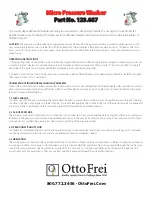
SM1633
20
USING THE MACHINE
Some stains cannot be removed by just washing in a washing machine. Before trying to remove any
type of stain by hand, first try the removal procedure on a small area of hidden fabric starting from the
edge of the stain and working inwards, this will prevent a dark ring from forming around the site of the
stain. A few methods for removing stains are reported below.
INTERNATIONAL CLOTHING CARE SYMBOLS
Before placing the clothes in the washing machine and selecting the wash programme, examine the
symbols on the manufacturer’s label. The table reported below will provide a useful guide to reading
the symbols.
HOW TO REMOVE STAINS
GB
●
W
AX
: scrape the wax using a blunt point in
order not to damage the fabric. Then, with
the fabric placed between two pieces of ab-
sorbent paper, run a hot iron over the stain.
●
B
ALL
-
POINT
PENS
AND
FELT
-
TIP
PENS
: clean using
a soft cloth soaked in ethyl alcohol. Take
care not to spread the mark.
●
D
AMP
AND
MOULD
: if the fabric supports the use
of bleach, perform a wash cycle adding
bleach to the appropriate compartment in the
dispenser (see table of programmes). Other-
wise, soak the soiled part in hydrogen per-
oxide (10 volumes) and leave for 10 to 15
minutes.
●
L
IGHT
SCORCH
MARKS
CAUSED
BY
IRONING
: follow
the instructions for mould and damp.
●
R
UST
: use products specially designed for rust
stains, following the manufacturer’s instruc-
tions written on the packet.
●
C
HEWING
GUM
: rub ice over the mark, scrape
away as much as possible and then rub with
a cotton cloth soaked in acetone (alterna-
tively, use nail varnish remover).
●
P
AINT
: do not allow the paint to dry. Rub the
area with the solvent recommended by the
paint manufacturer (e.g. water, turps, trichlo-
roethylene), apply soap and then rinse.
●
L
IPSTICK
: stains on cotton or wool can be
eliminated using a cloth soaked in ether.
Stains on silk require the use of trichloroeth-
ylene.
●
N
AIL
VARNISH
: place a sheet of absorbent
paper on the stained material, then dampen
the back of the fabric with acetone, fre-
quently changing the paper placed over the
stain. Continue like this until the stain has
disappeared.
●
T
AR
OR
DIRT
: spread some fresh butter over
the stain, allow to stand and then wash with
oil of turpentine.
●
G
RASS
: delicately soap the stain, use diluted
bleach. Good results can be obtained on
woollen fabrics using 90% alcohol.
●
B
LOOD
: put into soak in cold water with
added salt, then wash with washing soap.




































